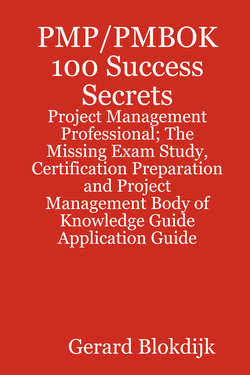Читать книгу PMP/PMBOK 100 Success Secrets - Project Management Professional; The Missing Exam Study, Certification Preparation and Project Management Body of Knowledge Application Guide - Gerard Blokdijk - Страница 17
ОглавлениеThird Edition
The Project Management Professional (PMP) is a certified individual by the Project Management Institute (PMI). PMI was established to standardize the project management best practices so that it can be applied into any discipline---from the IT industry to the construction industry. In 1987, PMI published a white paper which was known as the Project Management Book of Knowledge or PMBOK. Since then, the PMBOK has gone through three stages of revisions. The latest one, the PMBOK third edition supersedes the PMBOK 2000 which was published as the second edition of the very popular PMBOK guide.
PMI and ANSI set a clear definition and description of the best practices in the PMBOK 2000 guide. The guide includes knowledge and practices that are applicable to most projects from any industry and ensures that the projects are implemented within the time limit and within the specified budget. PMBOK 2000 has been replaced by the PMBOK third edition thanks to the various recommendations and improvements given to PMI. In PMBOK
2000, the following were revised and/or improved.
Most noticeable in the changes would be the physical ones.
Compared to PMBOK 2000, the PMBOK third edition has a new cover page, is 174 pages thicker, has better and improved illustrations and graphics and the application, implementation and revelation of best practices is in boldface for easy reference. Another big change from the PMBOK 2000 is that PMI has also introduced new sections on project management and has clarified several concepts and introduced new techniques in the PMBOK third edition.
27
Introduction to PMBOK 2004
The Project Management Book of Knowledge or PMBOK
2004 contains the essential principles, processes and knowledge for the successful implementation and management of any project.
The PMBOK 2004 also includes several proven best practices that are widely used by different industries and disciplines. With valuable contributions from certified members, the PMI reintroduced the PMBOK 2000 second edition. PMBOK 2004 was released and supersedes the PMBOK 2000 second edition guide to project management.
The PMBOK 2004 guide aims to identify the generally recognized good practices of project and program management applicable to all fields of study and industry from the IT to construction.
Exhaustive studies and explanations are excluded and only the knowledge and practices that are applicable to most projects most of the time are included in the discussion. These principles, practices and processes have been proven to be accepted and recognized by the different industries and will increase the chances of a successful implementation of a project. The PMBOK 2004 identifies
the project management team as the one responsible for the implementation of a project and identifying what is appropriate for it.
The PMBOK 2004 guide provides a foundation for basic reference and is recommended reading for individuals wishing to take the Certified Associate in Project Management (CAPM), the Project Management Professional (PMP), and the Program Management Professional (PgMP) exam certification, the Project Management education and training, and other accreditation programs in project management. The PMBOK 2004 guide is also recommended
reading for Senior Executives and Managers, Project/Program Managers, Stakeholders, Consultants, Educators, Trainers, Project Team Members, and any other individual involved in project management.
28
The PMBOK Lifecycle---The Core of
